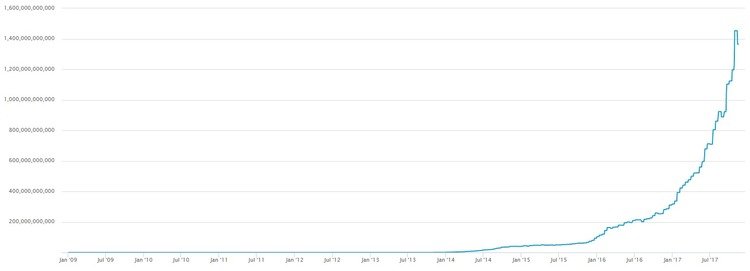How many bitcoins are yet to be mined?

Cryptocurrencies with limited and unlimited supply
Digital currencies can be divided into two types: with fixed supply, when a limit of coins emission is pre-installed in their structure, and with uncontrolled supply, when coins, contrariwise, can be mined forever. Among the 25 most capitalized cryptocurrencies, 17 (or 68%) of them have a limited supply. These are: Bitcoin (BTC), Bitcoin Cash (BCH), Ripple (XRP), Litecoin (LTC) etc. Remaining 8 cryptocurrencies of the list have no emission limits – for example, Ethereum (ETH), Monero (XMR), NEM (XEM) etc.
You can check out the chart below to see the distribution of mined coins which have a limited supply.
Table 1 – Emission of 25 most capitalized cryptocurrencies
|
Cryptocurrency |
Capitalization, bln |
Coins |
Supply limit, |
Proportion |
|
Bitcoin (BTC) |
117.6 |
16.8 |
21.0 |
80% |
|
Ethereum (ETH) |
32.2 |
96.9 |
n/a |
- |
|
Bitcoin Cash (BCH) |
21.4 | 16.9 | 21.0 | 80.5% |
|
Ripple (XRP) |
8.1 | 38739,1 | 100000.0 | 39% |
|
Litecoin (LTC) |
3.5 | 54.8 | 84.0 | 65% |
|
Dash (DASH) |
3.3 | 7.8 | 18.9 | 41% |
|
NEO (NEO) |
1.95 | 65.0 | 100.0 | 65% |
|
IOTA (MIOTA) |
1.9 | 2779.5 | 2779.5 | 100% |
|
Monero (XMR) |
1.9 | 15.6 | n/a | - |
|
NEM (XEM) |
1.8 | 9000.0 |
n/a |
- |
|
Ethereum Classic (ETC) |
1.7 | 99.1 |
n/a |
- |
|
Lisk (LSK) |
0.9 | 117 |
n/a |
- |
|
Qtum (QTUM) |
0.87 | 73.8 | 100.2 | 74% |
|
OmiseGO (OMG) |
0.79 | 102.0 | 140.2 | 73% |
|
EOS (EOS) |
0.77 | 604.9 | 1000.0 | 60.5% |
|
Zcash (ZEC) |
0.73 | 3.1 |
n/a |
- |
|
Hshare (HSR) |
0.73 | 42.5 | 84.0 | 50.6% |
|
Cardano (ADA) |
0.7 | 25927.1 | 45000.0 | 58% |
|
Stellar Lumens (XLM) |
0.6 | 17890.5 | 103432.4 | 17.3% |
|
Tether (USDT) |
0.59 | 1468.1 | 595.0 | 100% |
|
BitConnect (BCC) |
0.56 | 6.3 | 28.0 | 22.5% |
|
Waves (WAVES) |
0.5 | 100.0 |
n/a |
- |
|
Populous (PPT) |
0.4 | 37 | 53.3 | 69.4% |
|
Stratis (STRAT) |
0.35 | 98.7 |
n/a |
- |
|
Ark (ARK) |
0.3 | 98.0 | 129.2 | 76% |
Source: Bitnewstoday’s calculations based on Coinmarketcap data
How much bitcoins remain?
At the press time, more than 16.7 mln of bitcoin already circulate on the digital currency market, which makes 79% of established bitcoin supply limit. In other words, only 4.3 mln of bitcoins remain to be mined.
Bitcoin supply speed is written in its code and is strictly limited. Every 4 years, the mining halves. Apart from this, as the stats below show, every new block is harder to mine every new month.

Source: blockchain.info
When will all 21 million bitcoins be mined
Somewhere around 2140 the last 21 millionth bitcoin will emerge, and it is hard to predict what happens next. Some experts believe that at that time the price of Bitcoin will be more than a thousand times larger than the current one due to the deficit, and some believe that the developers would lift the bitcoin supply limit and the price would become stabilized.
And by the way, we must not forget that some BTC coins get lost during the circulation and relegate to the oblivion. DigRate has done a research on this and concluded that around 21% of mined bitcoins are “dead” and do not circulate at all.
Ether remaining
Web users often look up how much ether remains. As it was mentioned above, Ethereum developers have not set a supply limit and more than 95.7 mln of coins have already been mined.
Quite logically, the next question that comes into mind is how much will ethers cost once the bitcoin supply limit is reached and the ETH quantity will be much bigger than BTC (hundreds, if not thousands of times more). No single opinion about this yet: experts think that in the year 2140, when bitcoin supply ends, the cryptocurrency market will be completely different than we see today.
It should be noted that Vitalik Buterin, one of the founders of Ethereum, is already thinking about the ETH supply limit, but he intends not to copy Bitcoin solutions, but offers a more inventive way instead. The developer’s proposal is to fee the ETH blockchain-based applications. This, Buterin thinks, will help not to overload the market with tokens.
When it comes to the Ethereum mining difficulty, it increases overtime just like that of Bitcoin. But at the end of October 2017 after the protocol update, the mining became two times easier.

Source: bitinfocharts.com
Transaction speed increase: one of the primary goals of coin developers
After time, not only the money supply increases, but also the number and speed of transactions. Bitcoin can conduct around 7 transactions per minute, and Ethereum can do around 15 transactions per second.
“The number of network transactions is increasing relatively fast. Just in spring of this year, the number of them in the Ethereum network was 62,589, and now it has become around 530,000 transactions. No big changes in Bitcoin this year, however: the average yearly number equals 305,104 transactions,” tells Mikhail Mishenko, the analyst from eToro (social network for investors in Russia and the CIS).
The increase of transactions leads to the cryptocurrency scalability issue. To fulfill the hopes of cryptocurrency adepts and to get more competitive, the market still has much work to be done. Cryptocurrencies have examples to follow – to compare, VISA and MasterCard can make 4000 transactions per second.